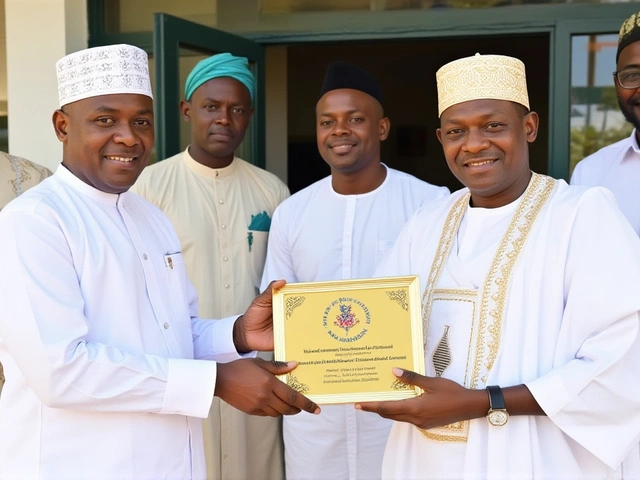On October 5, 2025, Ethiopia’s foreign ministry sent a sealed letter to UN Secretary-General António Guterres that read like a final warning: "Eritrea is actively preparing for war." Just weeks later, Prime Minister Abiy Ahmed told a closed-door security meeting, "Once war begins, no one can stop us." The words weren’t rhetoric—they were a mirror to the crumbling peace that once held the Horn of Africa together. The flashpoint? Ethiopia’s desperate, decades-long bid to regain direct access to the Red Sea, specifically the port of Assab, which became Eritrean soil when the country won independence in 1991. Now, with poverty soaring, armies mobilizing, and militias rearming, the region teeters on the edge of a conflict that could redraw borders—and bury thousands more.
From Allies to Adversaries: The Pretoria Pact That Broke
In 2020, Abiy Ahmed and President Isaias Afwerki were unlikely allies. Together, they crushed the Tigray People's Liberation Front (TPLF) in a brutal campaign that killed an estimated 500,000 people. Eritrean troops occupied Tigray. Ethiopian drones bombed villages. The world looked away. But when the Pretoria AgreementPretoria was signed in November 2022, Eritrea was left out. Ethiopia agreed to disarm the TPLF. Asmara expected more: total dismantling, permanent withdrawal of Tigrayan fighters, and full control over border crossings. What it got was ambiguity. And betrayal.By mid-2023, Eritrean forces refused to leave Tigray. Ethiopia responded by launching its own military push, forcing Eritrea’s troops out. The ceasefire held—barely. But the trust was gone. Asmara began quietly backing hardline TPLF factions led by Debretsion Gebremichael, while also arming the Fano militia in Amhara. "It’s not about ideology," says analyst Gelila Enbaye. "It’s about chaos as a strategy. Eritrea doesn’t want peace. It wants Ethiopia too weak to challenge it."
Red Sea or Ruin: Ethiopia’s Desperation
Ethiopia hasn’t had a coastline since 1991. Since then, it’s relied on Djibouti’s ports—costly, politically fragile, and vulnerable to disruption. In September 2025, the Ethiopian Army posted a video on Facebook: soldiers standing before a map of the Red Sea, flags fluttering. The caption: "We will pay any price to reclaim Assab." It went viral. In Addis Ababa, state media began airing documentaries on Ethiopia’s "historical maritime rights." The message was clear: this isn’t just about trade. It’s about national dignity.But Eritrea sees it differently. In January 2025, Isaias Afwerki and Egypt issued a joint statement: "Red Sea security belongs to coastal states." It was a warning shot. Ethiopia isn’t asking to rent a dock. It’s demanding sovereignty over Eritrean territory. And Asmara won’t blink. "They think we’re weak," a senior Eritrean defense official told a regional diplomat last month. "They forget we’ve survived sanctions, isolation, and war for 30 years. We don’t surrender land. We don’t negotiate from fear."
The Human Cost of a Coming Storm
Behind the political posturing lies a humanitarian catastrophe still unfolding. According to a World Bank report released in October 2025, Ethiopia’s poverty rate has jumped from 33% in 2016 to a projected 43% in 2025. Inflation hovers near 30%. Debt service consumes nearly half of government revenue. Meanwhile, UNHCR estimates 878,000 people remain internally displaced in Tigray—many living in makeshift shelters without clean water or medicine.Then there’s the silence on justice. Human Rights Watch reported on November 21, 2025, that neither Ethiopia nor Eritrea has prosecuted a single soldier or official for atrocities committed between 2020 and 2022. Mass graves in Western Tigray. Rape used as a weapon. Ethnic cleansing of Tigrayans by Amhara militias. The UN dropped its international inquiry in 2023 after Addis Ababa pressured member states. "We’re not just watching a peace process fail," said HRW’s Africa director. "We’re watching a society forget how to mourn."
Who’s Left to Stop This?
The African Union, the United States, Kenya, and South Africa are the official guarantors of the Pretoria Agreement. But they’ve been quiet. Diplomats in Addis say the U.S. is focused on Ukraine and Gaza. The AU is paralyzed by internal divisions. Kenya, traditionally a mediator, is now wary of alienating Eritrea—a key partner in counterterrorism efforts along the Somali border.On November 6, 2025, a new flashpoint: TPLF-aligned fighters crossed into Ethiopia’s Afar region, seizing three districts. The federal government called it an invasion. Debretsion’s faction denied it—then accused the Ethiopian military of drone strikes that killed 14 civilians. The next day, they sent another letter to António Guterres. The cycle had begun again.
What Comes Next?
Military analysts say Ethiopia could launch a limited incursion into Eritrean territory by early 2026—perhaps targeting the port of Assab or the strategic town of Zalambessa. Eritrea, with its conscript army of over 200,000 and recently tested short-range missiles, would respond with artillery barrages and cyberattacks on Ethiopian infrastructure. The result? A regional war that could spill into Sudan, Djibouti, and even the Red Sea shipping lanes—threatening $3.4 trillion in global trade annually.There’s still time. But not much. The window for diplomacy is closing faster than the humanitarian aid convoys can reach Tigray. The world needs to act—not with statements, but with sanctions, backchannel talks, and a revived UN fact-finding mission. Because if this war starts, it won’t end with a ceasefire. It’ll end with another generation buried in silence.
Frequently Asked Questions
Why is the port of Assab so important to Ethiopia?
Assab is Ethiopia’s most direct route to the Red Sea, cutting shipping times by 40% compared to Djibouti. Since Eritrea’s independence in 1991, Ethiopia has paid billions in port fees and faced political leverage from Djibouti. Reclaiming Assab would give Ethiopia sovereign control over its trade routes, reducing dependency on neighbors—and boosting its economy amid soaring inflation and debt.
Is Eritrea really backing armed groups inside Ethiopia?
Yes. Ethiopian officials, UN sources, and independent analysts confirm Eritrea has provided weapons, funding, and safe haven to both the Fano militia in Amhara and hardline TPLF factions. This isn’t ideology—it’s strategic chaos. By keeping Ethiopia destabilized, Asmara prevents Addis from focusing on reclaiming territory or building military strength near its border.
Why hasn’t the international community acted sooner?
Many Western powers prioritize counterterrorism and trade over human rights in the Horn. Eritrea is a key partner in monitoring Somali militant groups, and Ethiopia is Africa’s second-most populous nation and a growing market. The African Union, meanwhile, avoids confronting member states over internal conflicts. The result? A dangerous vacuum where violence goes unchecked.
What happened to the 2022 Pretoria peace deal?
The Pretoria Agreement ended major fighting but left critical issues unresolved: Eritrea’s troop withdrawal, TPLF disarmament, and territorial control. Eritrea wasn’t invited to the talks, and Ethiopia failed to fully implement terms. Asmara saw this as betrayal. Now, the agreement is effectively dead—replaced by mutual suspicion and covert warfare.
Could this conflict lead to genocide again?
Experts warn it’s possible. The same ethnic fault lines—Tigrayan, Amhara, Oromo—are re-emerging. In 2020–2022, over 600,000 people died and millions were displaced. With no accountability, no justice, and militias now rearming, the conditions for mass atrocities are already in place. Human Rights Watch says the risk of "renewed cycles of atrocities" is "all too real."
What’s the likelihood of war breaking out in 2026?
Military analysts estimate a 65–75% chance of major conflict by mid-2026. Ethiopia’s troop buildup near the border, Eritrea’s missile tests, and the recent cross-border incursions suggest both sides are preparing for escalation. A single incident—a drone strike, a border skirmish, a mistaken kill—could trigger full-scale war before diplomats even meet.







Narinder K
So let me get this straight - Ethiopia wants a port, Eritrea says ‘nope’, and the world’s busy scrolling TikTok? 😅
Narayana Murthy Dasara
Man, this whole thing just breaks my heart. People forget these aren’t just borders on a map - they’re families split apart, kids who’ve never seen the sea, elders who still remember when Assab was part of their world. We need real diplomacy, not just sanctions and silence. The Horn’s been bleeding too long.
lakshmi shyam
Abiy’s just another corrupt strongman playing hero while his people starve. And Isaias? A paranoid dictator with a cult of personality. Both deserve to burn. No sympathy for either side.
Sabir Malik
You know, I’ve been thinking about this for days now - it’s not just about land or ports, it’s about identity. Ethiopia lost its coastline in 1991 and never got over it. It’s like losing a limb and being told to just walk differently. But Eritrea? They built a nation out of isolation, trauma, and sheer stubbornness. Neither side is innocent. Both are trapped in a cycle where the only language they understand is force. And now we’re watching it all spiral again, while the world watches Netflix.
Debsmita Santra
What’s being ignored here is the structural violence of economic dependency - Ethiopia’s reliance on Djibouti isn’t just logistical it’s geopolitical vulnerability baked into colonial-era borders that never accounted for post-independence realities. The Pretoria Agreement failed because it treated symptoms not causes. We need regional integration frameworks not ceasefire theater. The AU needs teeth not press releases
Vasudha Kamra
This situation is a textbook example of how peace agreements without inclusive participation inevitably collapse. Eritrea was excluded from Pretoria, so of course they responded with asymmetric destabilization. Accountability for war crimes is non-negotiable. Without justice, peace is just a pause.
Abhinav Rawat
There’s something almost tragic about how nations become defined by what they’ve lost. Ethiopia doesn’t want Assab because it’s profitable - it wants it because it’s the last ghost of a sovereignty that was taken. Eritrea won its freedom by blood, and now it guards every inch like a mother with a child who almost died. War isn’t about maps - it’s about memory. And memory, once wounded, never fully heals.
Shashi Singh
ALERT!!! THE GLOBALIST ELITE ARE USING THIS WAR TO DEPLOY SATTELITE WEAPONS TO CONTROL AFRICAN MIGRATION ROUTES!!! Eritrea’s missiles? Fake! They’re actually quantum drones from the IMF!!! And that UN letter? It’s coded with RFID chips to track every Tigrayan refugee!!! They’re using the Red Sea as a testing ground for population control!!! I saw a guy on X with a drone photo - the port lights form a pentagram at midnight!!! #WakeUp!!!
Surbhi Kanda
Let’s be clear - no sovereign state cedes territory under duress. Ethiopia’s demands violate the UN Charter’s principle of territorial integrity. Eritrea’s response, while harsh, is legally defensible. But the real failure is the AU’s refusal to enforce its own protocols. Diplomacy isn’t optional - it’s the only tool left.
Sandhiya Ravi
I just keep thinking about the kids in Tigray who’ve never seen a hospital or clean water and now they’re being told to prepare for war again. How do you teach a child to hope when the whole world keeps turning away? We need more than statements - we need people on the ground, real aid, real protection. No more silence.
JAYESH KOTADIYA
Bro… Ethiopia’s been begging for a beach since 1991 😂 Meanwhile Eritrea’s been running a military bootcamp with 200k conscripts and zero Netflix. Of course they’re gonna fight. And the world? Still posting #PrayForEthiopia while sipping oat milk lattes. 🤡
Ravish Sharma
Let’s be real - this isn’t about ports. It’s about pride. Ethiopia’s trying to rewrite history like it’s a Wikipedia page. Eritrea? They’ve been surviving on spite and coffee since 1991. And now the world’s acting surprised? Please. This was always going to end in fire. The only surprise? That it took this long.
jay mehta
WE CAN DO BETTER THAN THIS!!! 🌍💛 The Horn needs unity not war! Look at how far we’ve come in India with peace talks - why can’t we do the same here? Let’s fund peace camps, youth exchanges, cultural bridges! Let’s make sure the next generation doesn’t grow up hating each other! This isn’t just politics - it’s humanity!!! LET’S ACT NOW!!!